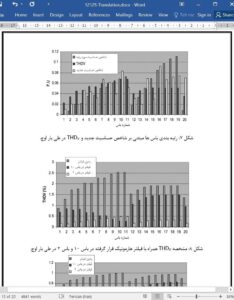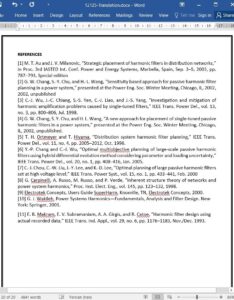Abstract
This paper presents an approach to determine strategic buses for harmonic filter placement by correlating the sensitivity index based on the inherent structure theory network (ISTN) and harmonic current injection at buses of the distribution network/feeder. The strategic buses for the harmonic filter are characterized as either the bus with maximum total harmonic voltage distortion (THDV) in a distribution feeder, or the bus where the placement of the harmonic filter would result in maximum reduction in the overall average THDV in the distribution feeder. The advantage of using this approach is that it provides insight into the interaction of the network structure with harmonic current sources in the distribution network in regards to the performance of harmonic filters. The assessment of the performance of a strategically placed passive harmonic filter based on the proposed approach is evaluated for peak and offpeak load scenarios on a radial distribution network. The results indicate that passive harmonic filters that are placed based on harmonic current emission levels perform better than harmonic filters placed based on ISTN alone. The strategically placed passive harmonic filters are highly effective in controlling harmonic propagation in distribution networks.
I. INTRODUCTION
THE increase in harmonic levels in distribution networks in recent years is largely caused by a constant growth in nonlinear loads (electronics and power electronics devices) in the customer installations. Taken individually, they are mostly single-phase low-power devices that draw nonlinear currents from the network. Due to a very large number of individual devices in customer facilities (or in the part of the network) and despite the natural harmonic cancellation, they may cause significant harmonic distortion at the utility substation. The individual devices in commercial areas, which particularly abound in nonlinear loads, include fluorescent lighting, computers, and their peripherals, office machines, heat pumps, and central air-conditioning (HVAC) with variable speed drives.
VII. CONCLUSION
This paper presented three approaches (two based on sensitivity indices and one based on average harmonic current emission level) to identify strategic buses for the placement of harmonic filters in the radial distribution feeder, the bus sensitivity method, and the harmonic current emission level method. Two of those (more suitable for application in realistic distribution networks) were discussed and illustrated in detail. While the approaches can only be considered as approximation techniques, the results are promising. In particular, the approaches provide insight into the interaction of harmonic current sources, network structure (sensitivity index), and location of the harmonic filter. They clearly demonstrate that highly sensitive network buses having relatively high harmonic current emission levels are strategically effective buses for the placement of harmonic filters. Harmonic filters placed at those buses are able to modify (i.e., reduce) the sensitivity of the respective buses and act as sinks for harmonic currents. Two new indices are proposed in the paper that can be used as a guide for the strategic placement of harmonic filters. This type of information is very useful for distribution planning engineers.











